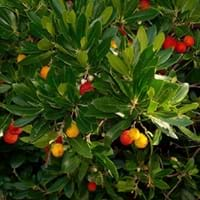Life Span
Perennial
Perennial
Type
Bulb or Corm or Tuber
Tree
Origin
South America
Hybrid origin
Types
Pamianthe cardenasii , Pamianthe parviflora , Pamianthe peruviana
Not Available
Number of Varieties
Not Available
Habitat
All sorts of environments
All sorts of environments
USDA Hardiness Zone
8-10
7-9
Sunset Zone
21,22
8, 9, 14, 15, 16, 17, 18, 19, 20, 21, 22, 23, 24
Habit
Clump-Forming
Twisted/Contorted
Flower Color Modifier
Bicolor
Bicolor
Leaf Color in Spring
Dark Green
Green, Dark Green
Leaf Color in Summer
Light Green
Dark Green
Leaf Color in Fall
Several shades of Green
Dark Green
Leaf Color in Winter
Light Green
Dark Green
Leaf Shape
Strap shaped
Oval
Plant Season
Spring, Summer, Fall
Spring, Summer, Fall, Winter
Sunlight
Partial Sun, Partial shade
Full Sun, Partial Sun, Partial shade
Type of Soil
Loam, Sand
Clay, Loam, Sand
The pH of Soil
Acidic, Neutral, Alkaline
Acidic, Neutral
Soil Drainage
Average
Well drained
Bloom Time
Spring, Late Spring, Early Summer, Summer, Late Summer
Spring, Late Spring, Fall, Late Fall, Early Winter
Tolerances
Drought
Drought, Salt
Where to Plant?
Ground, Pot
Ground
How to Plant?
Offsets
Budding, Seedlings, Stem Cutting
Plant Maintenance
Medium
Medium
Watering Requirements
Keep the ground moist but not water-logged
Allow to dry out slightly between watering, Average Water Needs
In Summer
Lots of watering
Lots of watering
In Spring
Moderate
Moderate
In Winter
Average Water
Average Water
Soil pH
Acidic, Neutral, Alkaline
Acidic, Neutral
Soil Type
Loam, Sand
Clay, Loam, Sand
Soil Drainage Capacity
Average
Well drained
Sun Exposure
Partial Sun, Partial shade
Full Sun, Partial Sun, Partial shade
Pruning
Pinch or prune as they grow to promote branching and bushiness, Remove damaged leaves, Remove dead branches, Remove dead leaves, Requires little pruning
Cut leaves after fall, Cut upper 1/3 section when young to enhancegrowth, Remove damaged leaves, Remove dead branches, Remove dead leaves
Fertilizers
All-Purpose Liquid Fertilizer, High phosphorus
All-Purpose Liquid Fertilizer, Compost, fertilize in growing season
Pests and Diseases
Leaf spot, Mosaic viruses
Aphids, Bacteria wilt, Fungal Diseases, Rats, Red blotch
Plant Tolerance
Drought
Dry soil, Salt and Soil Compaction, Shallow soil
Flower Petal Number
Single
Single
Fragrant Flower
No
Not Available
Fragrant Fruit
No
Not Available
Fragrant Leaf
No
Not Available
Fragrant Bark/Stem
No
Not Available
Foliage Texture
Coarse
Medium
Foliage Sheen
Glossy
Matte
Attracts
Bees, Birds, Bumblebees, Butterflies, Hummingbirds, pollinators
Birds
Allergy
Unknown
allergic conjunctivitis, Itchy eyes, Respiratory problems
Aesthetic Uses
Beautification, Bouquets, Ornamental use, Showy Purposes
Beautification, Hanging Basket, Showy Purposes
Beauty Benefits
No Beauty Benefits
Beautiful Skin, Good for the Scalp, Moisturizing, Remove blemishes
Environmental Uses
Air purification
Absorbs greenhouse gases, Food for animals, Insect Repellent, Prevent Soil Erosion, Shadow Tree
Medicinal Uses
No Medicinal Use
Acne, Dysentry, Nutritive, osteoporosis
Part of Plant Used
Not Available
Flowers, Fruits, Leaves
Other Uses
Beneficial species for attracting pollinators, Decoration Purposes
Animal Feed, Application in Handicrafts, Biomass for fuel, Oil is used for aromatherapy
Used As Indoor Plant
No
No
Used As Outdoor Plant
Yes
Yes
Garden Design
Bog Garden, Container, Feature Plant, Foundation, Mixed Border, Water Gardens
Feature Plant, Mixed Border
Botanical Name
HYMENOCALLIS longipetala
Arbutus menziesii
Common Name
Peruvian Daffodil, Spiderlily
Arbutus
In Hindi
peruvian daffodil
सदाबहार
In German
peruvian daffodil
Erdbeerbaum
In French
peruvian daffodil
arbousier
In Spanish
Pamianthe
Arbitus
In Greek
peruvian daffodil
κουμαριά
In Portuguese
peruvian daffodil
árbuto
In Polish
peruvian daffodil
mącznik
In Latin
peruvian daffodil
arbutus
Phylum
Magnoliophyta
Magnoliophyta
Class
Liliopsida
Not Available
Order
Asparagales
Ericales
Family
Amaryllidaceae
Ericaceae
Clade
Angiosperms, Monocots
Angiosperms, Asterids, Eudicots
Tribe
Clinantheae
Not Available
Subfamily
Amaryllidoideae
Arbutoideae
Number of Species
Not Available
Importance of Peruvian Daffodil and Arbutus
Want to have the most appropriate plant for your garden? You might want to know the importance of Peruvian Daffodil and Arbutus. Basically, these two plants vary in many aspects. Compare Peruvian Daffodil and Arbutus as they differ in many characteristics such as their life, care, benefits, facts, etc. Every gardener must at least have the slightest clue about the plants he wants to plant in his garden. Compare their benefits, which differ in many ways like facts and uses. The medicinal use of Peruvian Daffodil is No Medicinal Use whereas of Arbutus is Acne, Dysentry, Nutritive and osteoporosis. Peruvian Daffodil has beauty benefits as follows: No Beauty Benefits while Arbutus has beauty benefits as follows: No Beauty Benefits.
Compare Facts of Peruvian Daffodil vs Arbutus
How to choose the best garden plant for your garden depending upon its facts? Here garden plant comparison will help you to solve this query. Compare the facts of Peruvian Daffodil vs Arbutus and know which one to choose. As garden plants have benefits and other uses, allergy is also a major drawback of plants for some people. Allergic reactions of Peruvian Daffodil are Unknown whereas of Arbutus have allergic conjunctivitis, Itchy eyes and Respiratory problems respectively. Having a fruit bearing plant in your garden can be a plus point of your garden. Peruvian Daffodil has no showy fruits and Arbutus has showy fruits. Also Peruvian Daffodil is not flowering and Arbutus is not flowering . You can compare Peruvian Daffodil and Arbutus facts and facts of other plants too.





